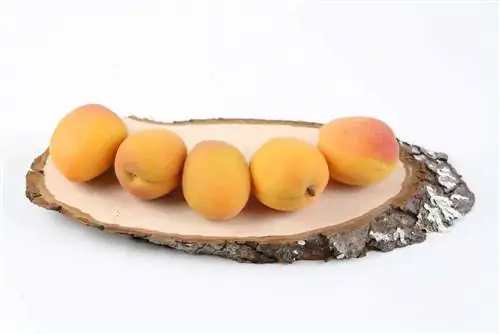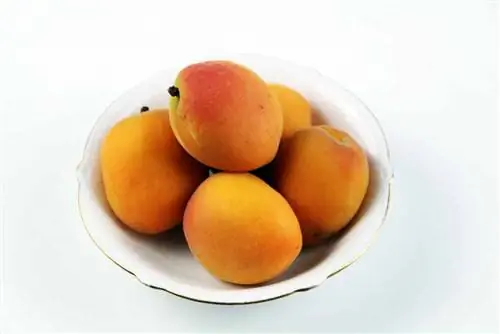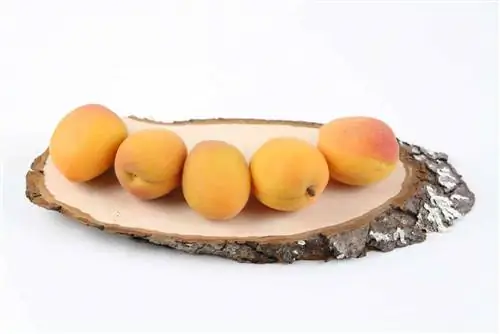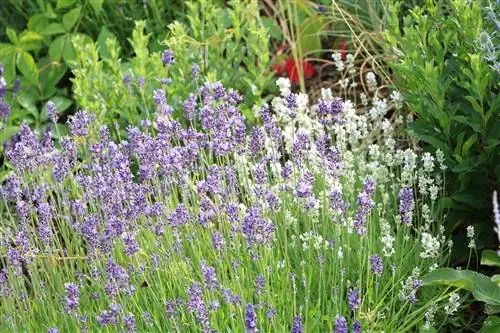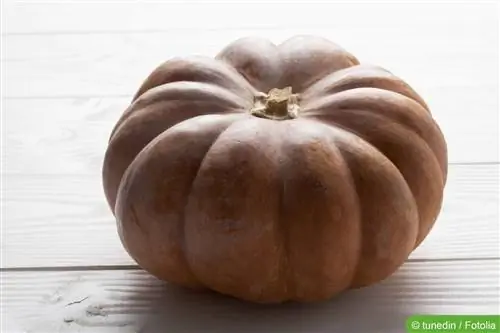- Author admin [email protected].
- Public 2023-12-17 03:39.
- Last modified 2025-01-24 12:45.
Apricot trees can be a bit difficult. Depending on the variety, a frost or various diseases can quickly ruin a reasonable harvest. With apricots, even more than with other fruit trees, the ideal location and varieties that are as resistant as possible are important. And of course the right care. To make things as easy as possible right from the start, you should lay the right foundations when purchasing the tree.
Growing apricot trees
Two factors are particularly important when growing apricot trees - the variety chosen and the location. If you do everything right here, there won't be much standing in the way of a good harvest. A wrong choice, however, can lead to considerable disappointment at the latest when harvesting. First, let's look at the location. Apricots love it warm and sunny. A location in full sun is therefore a must. It should also be protected from wind and somewhat from rain, as the flowers and fruits are very sensitive to strong gusts of wind and heavy rain. A sunny spot in close proximity to a house wall is ideal. It should be noted that the tree requires a total area of around eight square meters in order to be able to develop freely. The soil should be as nutrient-rich as possible. A moderately stony loess or clay soil that also has a high proportion of humus is perfect. If you don't have such a location or soil available, growing an apricot tree is basically possible, but you should be prepared for rather low yields.
Tip:
When planting the young tree, mix the existing soil well with leaf or bark compost in the root area. This increases the humus content enormously.
Varieties from A to Z
Apricot trees lived in the shadows in our gardens for a long time and were hardly in demand. That has now fundamentally changed. More and more hobby gardeners are discovering the apricot as an attractive fruit for their garden. It's no surprise that retailers are also responding to the increased demand. There you can now find a relatively large selection of varieties, all of which are in principle suitable for cultivation in our latitudes. The most common are:
- Ambrosia: medium-sized, very juicy fruit
- Compacta: juicy, medium-sized fruit
- Gold Rich: extremely sweet, aromatic and rather small fruit
- Hargrand: rather sour and medium-sized fruit
- Harlayne: juicy, small to medium sized fruit
- Kioto: aromatic, firm, medium-sized fruit
- Kuresia: very aromatic, sweet, slightly sour fruit
- Luizet: very juicy and very sweet medium-sized fruit
- Mino: sweet, juicy, medium-sized fruit
- Mombacher Frühe: very juicy, not so sweet, medium-sized fruit
- Nancy: sweet, big fruit
- Orangered: juicy, sweet, firm and very large fruit
- Prunus armeniaca: sweet and rather small fruit (dwarf fruit tree)
- Shipleys Blenheim: juicy, very aromatic medium-sized fruit
- Temporao de Villa Franca: juicy, sweet-sour, firm fruit of medium size
- Uhlhorn's miracle apricot: very juicy, aromatic, medium-sized fruit
- Hungarian best: sweet, slightly sour, medium-sized fruit
- True early apricot: very aromatic and large fruits
- Dwarf column gold fire: sweet, juicy, small fruits (dwarf fruit trees)
Particularly recommended varieties
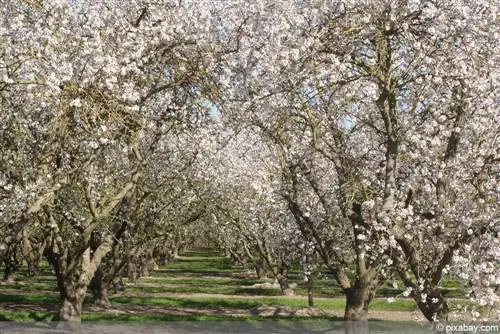
The varieties listed above are generally suitable for cultivation under the climatic conditions that largely prevail here. However, they differ enormously in terms of their susceptibility to diseases and pests, their sensitivity to cold and their yield. If you really want to be on the safe side, the following varieties are particularly recommended:
- Compacta, which has a compact, rather weak growth habit, but is resistant to frost
- Gold Rich (also often spelled Goldrich): extremely easy to care for, robust, resistant to almost all diseases that can affect apricot trees, frost hardy, late harvest
- Hargrand, also very resistant, insensitive, high yield
- Harlayne, robust and above all extremely productive
- Kuresia, also very robust, frost-hardy and the only variety resistant to Scharka disease
- Kioto, very frost hardy, with extremely strong growth
- Luizet: robust, resistant, can cope well with rather harsh climatic conditions
As a hobby gardener, you really can't go wrong with these three varieties. They are characterized not least by the fact that they prove to be extremely robust against diseases. You have to know that apricot trees are generally very susceptible to bacteria, viruses and fungi. These usually penetrate the plant through injuries to the tree. Therefore, in addition to a protected location, careful, careful tree pruning is also recommended.
Dwarf fruit trees
What applies to conventional apricot trees also applies particularly to dwarf fruit trees or columnar apricots. Even with the popular mini version, the location and the planting substrate must be right. If you want to cultivate the trees in a planter, you should also make sure that it has a volume of at least 30 liters. In addition, under no circumstances should waterlogging occur during watering. Among the dwarf fruit trees, these two apricot varieties are particularly recommended:
- Gold Rich (Goldrich) as a dwarf fruit tree with similar properties to its big brother
- Golden Sun as a columnar apricot, whose fruits should only be consumed fresh or processed immediately
- Rosina, which is perfect for cultivation in a bucket or planter
Dwarf fruit trees require significantly more attention and care than conventional fruit trees. In addition to constant watering, fertilization plays a major role. Fertilization should only be done with compost. However, you save work when pruning trees. This is significantly lower for dwarf fruit trees. However, you should be aware that the yield of these tiny plants is also limited. The fruits are often significantly sweeter and more aromatic. And in order to avoid any misunderstandings: dwarf fruit trees can be grown on the terrace or balcony, but are not suitable as houseplants.
Conclusion
Apricot trees have long been considered extremely mimosa-like. The reasons for this were, on the one hand, their high susceptibility to diseases and, on the other hand, their sensitivity to cold temperatures. Extremely low temperatures in particular could kill off many varieties very quickly. Fortunately, this has changed to a certain extent. With frost-hardy varieties such as those listed above, the dreaded late frosts in spring are no longer a big problem. However, it is important that these special varieties also have a generally warm, sunny location. Even if they can withstand one or two nights of frost, they still require higher temperatures in order to really thrive and produce a rich harvest. Last but not least, the sun also plays a major role in the aroma and sweetness of the fruit. If you want to plant an apricot tree in your garden, you should definitely focus on a frost-hardy, robust variety and the right location.

